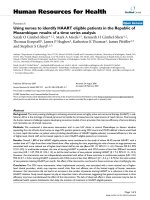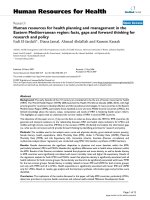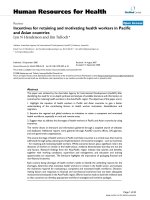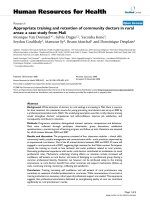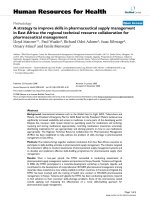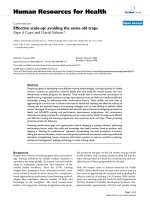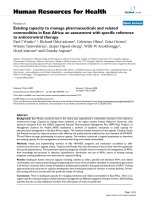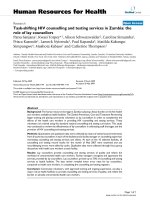Báo cáo sinh học: " Exploiting periodicity to extract the atrial activity in atrial arrhythmias" pptx
Bạn đang xem bản rút gọn của tài liệu. Xem và tải ngay bản đầy đủ của tài liệu tại đây (613.32 KB, 45 trang )
This Provisional PDF corresponds to the article as it appeared upon acceptance. Fully formatted
PDF and full text (HTML) versions will be made available soon.
Exploiting periodicity to extract the atrial activity in atrial arrhythmias
EURASIP Journal on Advances in Signal Processing 2011,
2011:134 doi:10.1186/1687-6180-2011-134
Raul Llinares ()
Jorge Igual ()
ISSN 1687-6180
Article type Research
Submission date 4 April 2011
Acceptance date 13 December 2011
Publication date 13 December 2011
Article URL />This peer-reviewed article was published immediately upon acceptance. It can be downloaded,
printed and distributed freely for any purposes (see copyright notice below).
For information about publishing your research in EURASIP Journal on Advances in Signal
Processing go to
/>For information about other SpringerOpen publications go to
EURASIP Journal on Advances
in Signal Processing
© 2011 Llinares and Igual ; licensee Springer.
This is an open access article distributed under the terms of the Creative Commons Attribution License ( />which permits unrestricted use, distribution, and reproduction in any medium, provided the original work is properly cited.
EURASIP Journal on Advances in Signal Processing manuscript No.
(will be inserted by the editor)
Exploiting periodicity to extract the atrial activity in
atrial arrhythmias
Raul Llinares
∗
and Jorge Igual
Departamento de Comunicaciones,
Universidad Polit´ecnica de Valencia, Camino
de Vera s/n, 46022 Valencia, Spain
∗
Corresponding author:
Email address:
JI:
Abstract Atrial fibrillation disorders are one of the main arrhythmias of the el-
derly. The atrial and ventricular activities are decoupled during an atrial fibrilla-
tion episode, and very rapid and irregular waves replace the usual atrial P-wave in
a normal sinus rhythm electrocardiogram (ECG). The estimation of these wavelets
is a must for clinical analysis. We propose a new approach to this problem focused
on the quasiperiodicity of these wavelets. Atrial activity is characterized by a main
atrial rhythm in the interval 3–12 Hz. It enables us to establish the problem as
the separation of the original sources from the instantaneous linear combination of
them recorded in the ECG or the extraction of only the atrial component exploit-
ing the quasiperiodic feature of the atrial signal. This methodology implies the
previous estimation of such main atrial perio d. We present two algorithms that
Address(es) of author(s) should be given
2Please give a shorter version with: \authorrunning and \titlerunning prior to \maketitle
separate and extract the atrial rhythm starting from a prior estimation of the main
atrial frequency. The first one is an algebraic method based on the maximization
of a cost function that measures the periodicity. The other one is an adaptive
algorithm that exploits the decorrelation of the atrial and other signals diagonal-
izing the correlation matrices at multiple lags of the period of atrial activity. The
algorithms are applied successfully to synthetic and real data. In simulated ECGs,
the average correlation index obtained was 0.811 and 0.847, respectively. In real
ECGs, the accuracy of the results was validated using spectral and temporal pa-
rameters. The average peak frequency and spectral concentration obtained were
5.550 and 5.554 Hz and 56.3 and 54.4%, respectively, and the kurtosis was 0.266
and 0.695. For validation purposes, we compared the proposed algorithms with
established methods, obtaining better results for simulated and real registers.
Keywords Source separation · Electrocardiogram · Atrial fibrillation · Periodic
component analysis · Second-order statistics
1 Introduction
In biomedical signal processing, data are recorded with the most appropriate tech-
nology in order to optimize the study and analysis of a clinically interesting ap-
plication. Depending on the different nature of the underlying physics and the
corresponding signals, diverse information is obtained such as electrical and mag-
netic fields, electromagnetic radiation (visible, X-ray), chemical concentrations or
acoustic signals just to name some of the most popular. In many of these different
applications, for example, the ones based on biopotentials, such as electro- and
magnetoencephalogram, electromyogram or electrocardiogram (ECG), it is usual
Exploiting periodicity to extract the atrial activity in atrial arrhythmias 3
to consider the observations as a linear combination of different kinds of biolog-
ical signals, in addition to some artifacts and noise due to the recording system.
This is the case of atrial tachyarrhythmias, such as atrial fibrillation (AF) or atrial
flutter (AFL), where the atrial and the ventricular activity can be considered as
signals generated by independent bioelectric sources mixed in the ECG together
with other ancillary sources [1].
AF is the most common arrhythmia encountered in clinical practice. Its study
has received and continues receiving considerable research interest. According to
statistics, AF affects 0.4% of the general population, but the probability of de-
veloping it rises with age, less than 1% for people under 60 years of age and
greater than 6% in those over 80 years [2]. The diagnosis and treatment of these
arrhythmias can be enriched by the information provided by the electrical signal
generated in the atria (f-waves) [3]. Frequency [4] and time–frequency analysis [5]
of these f-waves can be used for the identification of underlying AF mechanisms
and prediction of therapy efficacy. In particular, the fibrillatory rate has primary
importance in AF spontaneous behavior [6], response to therapy [7] or cardiover-
sion [8]. The atrial fibrillatory frequency (or rate) can reliably be assessed from
the surface ECG using digital signal processing: firstly, extracting the atrial signal
and then, carrying out a spectral analysis.
There are two main methodologies to obtain the atrial signal. The first one
is based on the cancellation of the QRST complexes. An established method for
QRST cancellation consists of a spatiotemporal signal model that accounts for
dynamic changes in QRS morphology caused, for example, by variations in the
electrical axis of the heart [9]. The other approach involves the decomposition of
the ECG as a linear combination of different source signals [10]; in this case, it
4Please give a shorter version with: \authorrunning and \titlerunning prior to \maketitle
can be considered as a blind source separation (BSS) problem, where the source
vector includes the atrial, ventricular and ancillary sources and the mixture is
the ECG recording. The problem has been solved previously using independent
component analysis (ICA), see [1,11]. ICA methods are blind, that is, they do
not impose anything on the linear combination but the statistical independence.
In addition, the ICA algorithms based on higher-order statistics need the signals
to be non-Gaussian, with the possible exception of one component. When these
restrictions are not satisfied, BSS can still be carried out using only second-order
statistics, in this case the restriction being sources with different spectra, allowing
the separation of more than one Gaussian component.
Regardless of whether second- or higher-order statistics are used, BSS meth-
ods usually assume that the available information about the problem is minimum,
perhaps the number of components (dimensions of the problem), the kind of combi-
nation (linear or not, with or without additive noise, instantaneous or convolutive,
real or complex mixtures), or some restrictions to fix the inherent indeterminacies
about sign, amplitude and order in the recovered sources. However, it is more re-
alistic to consider that we have some prior information about the nature of the
signals and the way they are mixed before obtaining the multidimensional record-
ing.
One of the most common types of prior information in many of the applications
involving the ECG is that the biopotentials have a periodic behavior. For example,
in cardiology, we can assume the periodicity of the heartbeat when recording a
healthy electrocardiogram ECG. Obviously, depending on the disease under study,
this assumption applies or not, but although the exact periodic assumption can be
very restrictive, a quasiperiodic b ehavior can still be appropriated. Anyway, the
Exploiting periodicity to extract the atrial activity in atrial arrhythmias 5
most important point is that this fact is known in advance, since the clinical study
of the disease is carried out usually before the signal processing analysis. This
is the kind of knowledge that BSS methods ignore and do not take into account
avoiding the specialization ad hoc of classical algorithms to exploit all the available
information of the problem under consideration.
We present here a new approach to estimate the atrial rhythm in atrial tach-
yarrhythmias based on the quasiperiodicity of the atrial waves. We will exploit
this knowledge in two directions, firstly in the statement of the problem: a sep-
aration or extraction approach. The classical BSS separation approach that tries
to recover all the original signals starting from the linear mixtures of them can be
adapted to an extraction approach that estimates only one source, since we are
only interested in the clinically significant quasiperiodic atrial signal. Secondly, we
will impose the quasiperiodicity feature in two different implementations, obtain-
ing an algebraic solution to the problem and an adaptive algorithm to extract the
atrial activity. The use of periodicity has two advantages: First, it alleviates the
computational cost and the effectiveness of the estimates when we implement the
algorithm, since we will have to estimate only second-order statistics, avoiding the
difficulties of achieving good higher-order statistics estimates; second, it allows the
development of algorithms that focus on the recovering of signals that match a
cost function that measure in one or another way the distance of the estimated
signal to a quasiperiodic signal. It helps in relaxing the much stronger assumption
of independence and allows the definition of new cost functions or the proper se-
lection of parameters such as the time lag in the covariance matrix in traditional
second-order BSS methods. The drawback is that the main period of the atrial
rhythm must be previously estimated.
6Please give a shorter version with: \authorrunning and \titlerunning prior to \maketitle
2 Statement of the problem
2.1 Observation model
A healthy heart is defined by a regular well-organized electromechanical activity,
the so-called normal sinus rhythm (NSR). As a consequence of this coordinated
behavior of the ventricles and atria, the surface ECG is characterized by a regu-
lar p eriodic combination of waves and complexes. The ventricles are responsible
for the QRS complex (during ventricular depolarization) and the T wave (during
ventricular repolarization). The atria generate the P wave (during atrial depolar-
ization). The wave corresponding to the repolarization of the atria is thought to
be masked by the higher amplitude QRS complex. Figure 1a shows a typical NSR,
indicating the different components of the ECG.
During an atrial fibrillation episode, all this coordination between ventricles
and atria disappears and they b ecome decoupled [9]. In the surface ECG, the
atrial fibrillation arrhythmia is defined by the substitution of the regular P waves
by a set of irregular and fast wavelets usually referred to as f-waves. This is due to
the fact that, during atrial fibrillation, the atria beat chaotically and irregularly,
out of coordination with the ventricles. In the case that these f-waves are not so
irregular (resembling a sawtooth signal) and have a much lower rate (typically
240 waves per minute against up to almost 600 for the atrial fibrillation case), the
arrhythmia is called atrial flutter. In Figure 1b, c, we can see the ECG recorded at
the lead V1 for a typical atrial fibrillation and atrial flutter episode, respectively,
in order to clarify the differences from a visual point of view among healthy, atrial
fibrillation and flutter episodes.
Exploiting periodicity to extract the atrial activity in atrial arrhythmias 7
From the signal processing point of view, during an atrial fibrillation or flutter
episode, the surface ECG at a time instant t can be represented as the linear combi-
nation of the decoupled atrial and ventricular sources and some other components,
such as breathing, muscle movements or the power line interference:
x(t) = As(t) (1)
where x(t) ∈
12×1
is the electrical signal recorded at the standard 12 leads in
an ECG recording, A ∈
12×M
is the unknown full column rank mixing matrix,
and s(t) ∈
M×1
is the source vector that assembles all the possible M sources
involved in the ECG, including the interesting atrial component. Note that since
the number of sources is usually less than 12, the problem is overdetermined (more
mixtures than sources). Nevertheless, the dimensions of the problem are not re-
duced since the atrial signal is usually a low power component and the inclusion
of up to 12 sources can be helpful in order to recover some novel source or a
multidimensional subspace for some of them, for example, when the ventricular
component is composed of several subcomponents defining a basis for the ventric-
ular activity subspace due to the morphological changes of the ventricular signal
in the surface ECG.
2.2 On the periodicity of the atrial activity
A normal ECG is a recurrent signal, that is, it has a highly structured morphology
that is basically repeated in every beat. It means that classical averaging methods
can be helpful in the analysis of ECGs of healthy patients just aligning in time
the different heartbeats, for example, for the reduction of noise in the recordings.
However, during an atrial arrhythmia, regular RR-period intervals disappear, since
8Please give a shorter version with: \authorrunning and \titlerunning prior to \maketitle
every beat becomes irregular in time and shape, being composed of very chaotic
f-waves. In addition, the ventricular response also becomes irregular, with higher
average rate (shorter RR intervals).
Attending to the morphology and rate of these wavelets, the arrhythmias are
classified in atrial flutter or atrial fibrillation, as aforementioned. This character-
istic time structure is translated to frequency domain in two different ways. In
the case of atrial flutter, the relatively slow and regular shape of the f-waves pro-
duces a spectrum with a high low frequency peak and some harmonics; in the case
of atrial fibrillation, there also exists a main atrial rhythm, but its characteristic
frequency is higher and the power distribution is not so well structured around
harmonics, since the signal is more irregular than the flutter. In Figure 2, we show
the spectrum for the atrial fibrillation and atrial flutter activities shown in Fig-
ure 1. As can be seen, both of them show a power spectral density concentrated
around a main peak in a frequency band (narrowband signal). In our case, the
main atrial rhythms correspond to 3.88 and 7.07 Hz for the flutter and fibrillation
cases, respectively; in addition, we can observe in the figure the harmonics for the
flutter case. This atrial frequency band presents slight variations depending on the
authors, for example, 4–9 Hz [12,13], 5–10 Hz [14], 3.5–9 Hz [11] or 3–12 Hz [15].
Note that even in the case of a patient with atrial fibrillation, the highly ir-
regular f-waves can be considered regular in a short period of time, typically up
to 2 s [5]. From a signal processing point of view, this fact implies that the atrial
signal can be considered a quasiperiodic signal with a time-varying f-wave shape.
On the other hand, for the case of atrial flutter, it is usually supposed that the
waveform can be modeled by a simple stationary sawtooth signal. Anyway, the
time structure of the atrial rhythm guarantees that the short time spectrum is
Exploiting periodicity to extract the atrial activity in atrial arrhythmias 9
defined by the Fourier transform of a quasiperiodic signal, that is, a fundamental
frequency in addition to some harmonics in the bandwidth 2.5–25 Hz [5].
In conclusion, the f-waves satisfy approximately the periodicity condition:
s
A
(t) s
A
(t + nP) (2)
where P is the period defined as the inverse of the main atrial rhythm and n is
any integer number. Note that we assume that the signals x(t) are obtained by
sampling the original periodic analog signal with a sampling p eriod much larger
than the bandwidth of the atrial activity.
The covariance function of the atrial activity is defined by:
ρ
s
A
(τ) = E
[
s
A
(t + τ)s
A
(t)
]
ρ
s
A
(τ + nP ) (3)
corresponding to one entry in the diagonal of the covariance matrix of the source
signals R
s
(τ) = E
s(t + τ)s(t)
T
. At the lag equal to the period, the covariance
matrix becomes:
R
s
(P ) = E
s(t + P)s(t)
T
(4)
As we mentioned before, the sources that are combined in the ECG are decou-
pled, so the covariance matrix is a diagonal one, that is, the off-diagonal entries
are null,
R
s
(P ) = Λ(P ) (5)
where the elements of the diagonal of Λ(P ) are the covariance of the sources
Λ
i
(P ) = ρ
s
i
(P ) = E
[
s
i
(t + P)s
i
(t)
]
.
10Please give a shorter version with: \authorrunning and \titlerunning prior to \maketitle
We do not require the sources to be statistically independent but only second-
order independent. This second-order approach is robust against additive Gaussian
noise, since there is no limitation in the number of Gaussian sources that the al-
gorithms can extract. Otherwise, the restriction is imposed in the spectrum of
the sources: They must be different, that is, the autocovariance function of the
sources must be different ρ
s
i
(τ). This restriction is fulfilled since the spectrum of
ventricular and atrial activities is overlapping but different [16]. Taking into ac-
count Equation 5, we can assure that the covariance matrices at lags multiple of P
will be also diagonal with one entry being almost the same, the one corresponding
to the autocovariance of the atrial signal.
3 Methods
3.1 Periodic component analysis of the electrocardiogram in atrial flutter and
fibrillation episodes
The blind source extraction of the atrial component s
A
(t) can be expressed as:
s
A
(t) = w
T
x(t) (6)
The aim is to recover a signal s
A
(t) with a maximal periodic structure by means
of estimating the recovering vector (w). In mathematical terms, we establish the
following equation as a measure of the periodicity [17]:
p(P ) =
t
|s
A
(t + P) −s
A
(t)|
2
t
|s
A
(t)|
2
(7)
where P is the period of interest, that is, the inverse of the fundamental frequency
of the atrial rhythm. Note that p(P ) is 0 for a periodic signal with period P . This
Exploiting periodicity to extract the atrial activity in atrial arrhythmias 11
equation can be expressed in terms of the covariance matrix of the recorded ECG,
C
x
(τ) = E
x(t + τ)x(t)
T
:
p(P ) =
w
T
A
x
(P ) w
w
T
C
x
(0)w
(8)
with
A
x
(P ) = E
[x(t + P) −x(t)][x(t + P) −x(t)]
T
=
= 2C
x
(0) −2C
x
(P ) (9)
As stated in [17], the vector w minimizing Equation 8 corresponds to the eigen-
vector of the smallest generalized eigenvalue of the matrix pair
(
A
x
(P ) , C
x
(0)
)
,
that is, U
T
A
x
(P )U = D, where D is the diagonal generalized eigenvalue matrix
corresponding to the eigenmatrix U that simultaneously diagonalizes A
x
(P ) and
C
x
(0), with real eigenvalues sorted in descending order on its diagonal entries.
In order to assure the symmetry of the covariance matrix and guarantee that
the eigenvalues are real valued, in practice instead of the covariance matrix, we
use the symmetric version [17]:
ˆ
C
x
(P ) =
C
x
(P ) + C
T
x
(P )
/2 (10)
The covariance matrix must be estimated at the pseudoperiod of the atrial
signal. The next subsection explains how to obtain this information. Once the
pair
ˆ
C
x
(P ), C
x
(0)
is obtained, the transformed signals are y(t) = U
T
x(t) corre-
sponding to the periodic components. The elements of y(t) are ordered according
to the amount of periodicity close to the P value, that is, y
1
(t) is the estimated
12Please give a shorter version with: \authorrunning and \titlerunning prior to \maketitle
atrial signal since it is the most perio dic component with respect to the atrial fre-
quency. In other words, attending to the previously estimated period P , the y
i
(t)
component is less periodic in terms of P than y
j
(t) for i > j.
Regarding the algorithms focused on the extraction of only one component,
perio dic component analysis allows the possibility to assure the dimension of the
subspace of the atrial activity observing the first components in y(t). With respect
to the BSS methods, it allows the correct extraction of the atrial rhythm in an
algebraic way, with no postprocessing step to identify it among the rest of ancillary
signals nor the use of a previous whitening step to decouple the components, since
we know that at least the first one y
1
(t) belongs to the atrial subspace. The fact
that we can recover more components can be helpful in situations where the atrial
subspace is composed of more than one atrial signal with similar frequencies. In
that case, instead of discarding all the components of the vector y(t) but the first
one, we could keep more than one.
If we are interested in a sequential algorithm instead of in a batch type solution
such as the periodic component analysis, we can exploit the fact that the vector
x(t) in Equation 1 can be understood as a linear combination of the columns of
matrix A instead of as a mixture of sources defined by the rows of A, that is, the
contribution of the atrial component to the observation vector is defined by the
corresponding column a
i
in the mixing matrix A. Following this interpretation of
Equation 1, one intuitive way to extract the ith source is to project x(t) onto the
space in
12×1
orthogonal to, denoted by ⊥, all of the columns of A except a
i
,
that is, {a
1
, . . . , a
i−1
, a
i+1
, . . . , a
12
}.
Therefore, the optimal vector w that permits the extraction of the atrial source
can be obtained by forcing s
A
(t) to be uncorrelated with the residual components
Exploiting periodicity to extract the atrial activity in atrial arrhythmias 13
in E
w
⊥
|t
= I −
tw
T
w
T
t
, the oblique projector onto direction w
⊥
, that is, the
space orthogonal to w, along t (direction of a
i
, the column i of the mixing matrix
A when the atrial component is the ith source). The vector w is defined for the
case of 12 sources as w⊥span {a
1
, . . . , a
i−1
, a
i+1
, . . . , a
1
2}.
The cost function to be maximized is:
J
w, t, d
0
, d
1
, . . . , d
Q
= −
Q
τ =0
R
x
(τ)w − d
τ
t
2
(11)
where d
0
, d
1
, . . . , d
Q
are Q + 1 unknown scalars and · denotes the Euclidean
length of vectors. In order to avoid the trivial solution, the constraints t = 1 and
d
0
, d
1
, . . . , d
Q
= 1 are imposed. One source is perfectly extracted if R
x
(τ)w =
d
τ
t, because t is collinear with one column vector in A, and w is orthogonal to
the other M − 1 column vectors in the mixing matrix.
If we diagonalize the Q + 1 covariance matrices R
x
(τ) at time lags the multiple
perio ds of the main atrial rhythm τ = 0, P, . . . , QP , the restriction
d
0
, d
1
, . . . , d
Q
=
1 implies d
0
= d
1
= ··· = d
Q
=
1
√
Q+1
, that is, the vector of unknown scalars
d
0
, d
1
, . . . , d
Q
is fixed and the cost function must be maximized only with respect
to the extracting vector. The final version of the algorithm (we omit details, see
[18]) is:
w =
Q
r=0
R
2
rP
−1
1
√
Q+1
Q
r=0
R
rP
t, w = w
/
w
t =
1
√
Q+1
Q
r=0
R
rP
w, t = t
/
t
(12)
Regardless of the algorithm we follow, the algebraic or sequential solution, both
of them require an initial estimation of the period P as a parameter.
14Please give a shorter version with: \authorrunning and \titlerunning prior to \maketitle
3.2 Estimation of the atrial rhythm period
An initial estimation of the atrial frequency must be first addressed. Although the
ventricular signal amplitude (QRST complex) is much higher than the atrial one,
during the T − Q intervals, the ventricular amplitude is very low. From the lead
with higher AA, usually V1 [12], the main peak frequency is estimated using the
Iterative Singular Spectrum Algorithm (ISSA) [15]. ISSA consists of two steps: In
the first one, it fills the gaps obtained on an ECG signal after the removal of the
QRST intervals; in the second step, the algorithm locates the dominant frequency
as the largest peak in the interval [3, 12] Hz of the spectral estimate obtained with
a Welch’s periodogram.
To fill the gaps after the QRST intervals are removed, SSA embeds the original
signal V1 in a subspace of higher-dimension M. The M-lag covariance matrix is
computed as usual. Then, the singular value decomposition (SVD) of the MxM
covariance matrix is obtained so the original signal can be reconstructed with the
SVD. Excluding the dimensions associated with the smaller eigenvalues (noise), the
SSA reconstructs the missing samples using the eigenvectors of the SVD as a basis.
In this way, we can obtain an approximation of the signal in the QRST intervals
that from a spectral point of view is better than other polynomial interpolations.
To check how many components to use in the SVD reconstruction, the esti-
mated signal is compared with a known interval of the signal, so when both of
them become similar, the number of components in the SVD reconstruction is
fixed. Figure 3 shows the block diagram of the method.
Exploiting periodicity to extract the atrial activity in atrial arrhythmias 15
4 Materials
4.1 Database
We will use simulated and real ECG data in order to test the performance of the
algorithms under controlled (synthetic ECG) and real situations (real ECG). The
simulated signals come from [11] (see Section 4.1 in [11] for details about the pro-
cedure to generate them); the most interesting property of these signals is that
the different components correspond to the same patient and session (preserving
the electrode position), being only necessary the interpolation during the QRST
intervals for the atrial component. The data were provided by the authors and
consist of ten recordings, four marked as ”atrial flutter” (AFL) and six marked as
”atrial fibrillation” (AF). The real recording database contains forty-eight regis-
ters (ten AFL and thirty eight AF) belonging to a clinical database recorded at
the Clinical University Hospital, Valencia, Spain. The ECG recordings were taken
with a commercial recording system with 12 leads (Prucka Engineering Cardio-
lab system). The signals were digitized at 1,000 samples per second with 16 bits
resolution.
In our experiments, we have used all the available leads for a period of 10
s for every patient. The signals were preprocessed in order to reduce the base-
line wander, high-frequency noise and power line interference for the later signal
processing. The recordings were filtered with an 8-coefficient highpass Chebyshev
filter and with a 3-coefficient lowpass Butterworth filter to select the bandwidth
of interest: 0.5–40 Hz. In order to reduce the computational load, the data were
downsampled to 200 samples per second with no significant changes in the quality
of the results.
16Please give a shorter version with: \authorrunning and \titlerunning prior to \maketitle
4.2 Performance measures
In source separation problems, the fact that the target signal is known allows
us to measure with accuracy the degree of performance of the separation. There
exist many objective ways of evaluating the likeliho od of the recovered signal,
for example, the normalized mean square error (NMSE), the signal-to-interference
ratio or the Pearson cross-correlation coefficient. We will use the cross-correlation
coefficient (ρ) between the true atrial signal, x
A
(t), and the extracted one, ˆx
A
(t);
for unit variance signals and m
x
A
, m
ˆ
x
A
is the means of the signals:
ρ = E
[
(x
A
(t) −m
x
A
)(ˆx
A
(t) −m
ˆ
x
A
)
]
(13)
For real recordings, the measure of the quality of the extraction is very difficult
because the true signal is unknown. An index that is extensively used in the BSS
literature about the problem is the spectral concentration (SC) [11]. It is defined
as:
SC =
1.17f
p
0.82f
p
P
A
(f)df
∞
0
P
A
(f)df
(14)
where P
A
(f) is the power spectrum of the extracted atrial signal ˆx
A
(t) and f
p
is the fibrillatory frequency peak (main peak frequency in the 3–12 Hz band). A
large SC is usually understood as a good extraction of the atrial f-waves because a
more concentrated spectrum implies better cancellation of low- and high-frequency
interferences due to breathing, QRST complexes or power line signal.
In time domain, the validation of the results with the real recordings will
be carried out using kurtosis [19]. Although the true kurtosis value of the atrial
component is unknown, a large value of kurtosis is associated with remaining
QRST complexes and consequently implies a poor extraction.
Exploiting periodicity to extract the atrial activity in atrial arrhythmias 17
4.3 Statistical analysis
Parametric or nonparametric statistics were used depending on the distribution of
the variables. Initially, the Jarque–Bera test was applied to assess the normality
of the distributions, and later, the Levene test proved the homoscedasticity of the
distributions. Next, the statistical tests used to analyze the data were ANOVA or
Kruskal–Wallis. Statistical significance was assumed for p < 0.05.
5 Results
The proposed algorithms were exhaustively tested with the synthetic and real
recordings explained in the previous section. We refer to them as periodic compo-
nent analysis (piCA) and periodic sequential approximate diagonalization (pSAD).
The prior information (initial period (
˜
P )) was estimated for each patient from the
lead V1 and was calculated as the inverse of the initial estimation of the main peak
frequency (
˜
P = 1/
˜
f
p
). In addition, for comparison purposes, we indicate the re-
sults obtained by two established methods in the literature: spatiotemporal QRST
cancellation (STC) [9] and spatiotemporal blind source separation (ST-BSS) [11].
5.1 Synthetic recordings
The results are summarized in Table 1. For the AFL and AF cases, it shows
the mean and standard deviation of correlation (ρ) and peak frequency (
ˆ
f
p
) values
obtained by the algorithms (the two proposed and the two established algorithms).
The mean true fibrillatory frequency is 3.739 Hz for the AFL case and 5.989 Hz
for the AF recordings (remember that in the atrial flutter case, the f-waves are
18Please give a shorter version with: \authorrunning and \titlerunning prior to \maketitle
slower and less irregular). The spectral analysis was carried out with the modified
perio dogram using the Welch-WOSA method with a Hamming window of 4,096
points length, a 50% overlapping between adjacent windowed sections and an
8,192-point fast Fourier transform (FFT).
The extraction with the proposed algorithms is very good, with cross-correlation
above 0.8 and with a very accurate estimation of the fibrillatory frequency. Com-
pared to the STC and ST-BSS methods, the results obtained by piCA and pSAD
are better, as we can observe in Table 1.
Figure 4 represents the cross-correlation coefficient (ρ) and the true (f
p
) and
estimated main atrial rhythm or fibrillatory frequency peak (
ˆ
f
p
) for the four AFL
and six AF recordings. For the sake of simplicity, Figure 4 only shows the results
for the two new algorithms. The b ehavior of both algorithms is quite similar; only
for patient 2 in the AFL case, the performance of pSAD is clearly better than
piCA.
We conclude that both algorithms perform very well for the synthetic signals
and must be tested with real recordings, with the inconvenience that objective
error measures cannot be obtained since there is no grounded atrial signal to be
compared to.
5.2 Real recordings
In the case of real recordings, we cannot compute the correlation since the true
f-waves are not available. To assess the quality of the extraction, the typical error
measures must be now substituted by approximative measurements. In this case,
SC and kurtosis will be used to measure the performance of the algorithms in
Exploiting periodicity to extract the atrial activity in atrial arrhythmias 19
frequency and time domain. In addition, we can still compute the atrial rate, that
is, the main peak frequency, although again we cannot measure its goodness in
absolute units. SC and
ˆ
f
p
values were obtained from the power spectrum using
the same estimation method as in the case of synthetic recordings.
We start to consider the extraction as successful when the extracted signal has
a SC value higher than 0.30 [15] and a kurtosis value lower than 1.5 [11]. Both
thresholds are established heuristically in the literature. We have confirmed these
values in our experiments analyzing visually the estimated atrial signals when
these restrictions are satisfied simultaneously. Hence, the comparison of the atrial
activities obtained for the same patient by the different methods is straightforward:
The signal with lowest kurtosis and largest SC will be the best estimate.
As for synthetic ECGs, we summarize the mean and standard deviation of the
quality parameters (SC, kurtosis and
ˆ
f
p
) obtained by the proposed and classic al-
gorithms in Table 2. The results obtained by piCA and pSAD are very consistent
again. The main atrial rhythm estimated is almost the same for all the recordings
for both algorithms. This fact reveals that both of them are using the same prior
and that they converge to a solution that satisfies the same quasiperiodic restric-
tion. With respect to the STC and ST-BSS algorithms, the results obtained by
piCA and pSAD are also better as in the case of synthetic ECGs. Note that the
kurtosis in the STC case is very large; this is due to the fact that the algorithm
was not able to cancel the QRST complex for some recordings.
Figure 5 shows the SC, kurtosis and main atrial frequency
ˆ
f
p
for the 10 patients
labeled as AFL (left part of the figure) and the 38 recordings labeled as AF (right
part of the figure) for pICA solution (circles) and pSAD estimate (crosses).
20Please give a shorter version with: \authorrunning and \titlerunning prior to \maketitle
To check whether the performances of the new algorithms are statistically
different, we calculated the statistical significance with the corresponding test for
the SC, kurtosis and frequency. We found no significant differences between piCA
and pSAD as we expected after seeing Figure 5, since the results are quite similar
for many recordings. On the other hand, when comparing piCA and pSAD with
STC and ST-BSS in all the cases, there were statistically significant differences (p <
0.05) for SC and kurtosis parameters. All the algorithms estimated the frequency
with no statistically significant differences.
To compare the signals obtained by the proposed algorithms for the same
recording, we show an example in Figure 6. It corresponds to patient number 5
with AF. We show the f -waves obtained by pSAD (top) and piCA (middle) scaled
by the factor associated with its projection onto the lead V1. In addition, we show
the signal recorded in lead V1 (bottom). As can be seen, they are almost identical
(this is not surprising since the SC and kurtosis values in Figure 5 are the same
for this patient); during the nonventricular activity perio ds, the estimated and the
V1 signals are very similar (the algorithms basically canceled the baseline); dur-
ing the QRS complexes, the algorithms were able to subtract the high-amplitude
ventricular component, remaining the atrial signal without discontinuities.
However, we can observe attending to the SC and kurtosis values in Figure
5 that the f-waves obtained by the two algorithms are not exactly the same for
the 48 recordings. The recordings where the estimated signals are clearly different
are number 2 and 8 for AFL and number 2 for AF case. We will analyze these
three cases in detail. For patient number 8 with AFL, the kurtosis value is high for
pSAD algorithm. Observing the signal in time (Figure 7, atrial signal recovered
by pSAD (top) and by piCA (middle), both scaled by the factor associated with
Exploiting periodicity to extract the atrial activity in atrial arrhythmias 21
its projection onto the lead V1, and lead V1 (bottom)), we can see that it is due
to one ectopic beat located around second 5.8 which pSAD was not able to cancel.
If we do not include it in the estimation of the kurtosis, it is reduced to 0.9, a
close to Gaussian distribution as we expected. This result confirms the goo dness
of kurtosis as an index to measure the quality of the extraction. Note that since it
is very sensitive to large values of the signal, it is a very good detector of residual
QRST complexes.
With respect to patient number 2 in AF, the kurtosis value is high for both
algorithms. Again, it is due to the presence of large QRS residues in the recovered
atrial activity. We show the recovered f-waves in Figure 8. This case does not
correspond to an algorithm failure, but it is due to a problem with the recording.
Nevertheless, the algorithms recover a quasiperiodic component and for the case
of pSAD even with an acceptable kurtosis value (it is able to cancel the beats
between seconds 6 and 8 of the recording).
The most interesting case is patient number 2 in AFL. Its explanation will
help us to understand the differences between both algorithms. Remember that
piCA solution is based on the decomposition of the ECG using as waveforms with
a period close to the main atrial period as a basis. We show in Figure 9 the first
four signals obtained by piCA for this patient.
The solution is algebraic, and there is no adaptive learning. The first recov-
ered signal is clearly the cleanest atrial component (remember that one advantage
of piCA with respect to classical ICA-based solutions is that we do not need a
postpro cessing to identify the atrial component, since in piCA the recovered com-
ponents are ordered by periodicity). The second one could be considered an atrial
signal too, although the f-waves are contaminated by some residual QRST com-
22Please give a shorter version with: \authorrunning and \titlerunning prior to \maketitle
plexes, for example, in second 1 or 2.5. In fact, this second atrial component is
very similar to the signal that recovers pSAD. Since pSAD is extracting only one
source, it is not able to recover the atrial subspace when it includes more than one
component. In this case, the problem arises because some of the QRS complexes
are by chance periodic with period the half of the f-waves period, so the signal
estimated by pSAD is also periodic with the correct period.
Next, we analyzed the convergence of the adaptive algorithm pSAD. It con-
verges very fast, requiring from 1 to 5 iterations to obtain the f-waves. In Figure
10, we show the extracted atrial signal for recording number 33 with AF after the
first, second and fifth iteration. As we can observe, just after two iterations, the
QRS complexes that are still visible after the first iteration have been canceled.
The remaining large values are continuously reduced in every iteration, obtaining
a very good estimate of the f-waves after five iterations.
Finally, we compared the requirements in terms of time for both algorithms.
The mean and standard deviation of the time consumed by the algorithms to
estimate the atrial activity for each patient were 0.0114 ± 0.0016 s for piCA and
0.0110 ± 0.0040 s for pSAD (for a fixed number of iterations of 20).
5.3 Influence of the estimation of the initial period
In this section, we study the influence of the initial estimation of the perio d in the
performance of the algorithms. From ISSA algorithm, we obtain an estimation of
the main peak frequency of the AA,
˜
f
p
, and then we convert it to period using
the expression
˜
P = 1/
˜
f
p
. In the experiment, we varied the initial estimation of
the period measured in samples, referred to as i
˜
P , from i
˜
P − 20 samples up to
Exploiting periodicity to extract the atrial activity in atrial arrhythmias 23
i
˜
P + 20 samples. Figures 11 and 12 show the results for the studied parameters:
SC, estimated peak frequency and kurtosis. The graphs correspond to the average
of the 38 AF patients. For a peak frequency of 6 Hz (the average frequency ob-
tained) and taking into account the sample frequency, every sample approximately
corresponds to 0.2 Hz ([i
˜
P − 20, i
˜
P + 20] samples that is equivalent to [2, 10] Hz
for a 6 Hz atrial activity).
6 Discussion
In this Section, we discuss the characteristics of the proposed algorithms, empha-
sizing the advantages and drawbacks, and their relationships with the solutions
based on the cancellation of the QRST complexes and BSS-ICA approach, repre-
sented by the STC and ST-BSS methods, respectively.
The algorithms piCA and pSAD use the pseudoperiodic property of the atrial
activity in time domain. They do not require whitening nor the use of higher-order
cumulants as found in BSS-ICA solutions. They only rely on the nonidentical
spectrum of the sources and exploit the periodicity feature in a different way.
The algorithm piCA is based on a cost function that measures periodicity; the
establishment of such a cost function in an appropriate way allows us to obtain an
algebraic solution, where the estimated components are ordered attending to this
perio dic criterion; the obtained algorithm has the great advantage with respect
to ICA-based algorithms that it avoids the typical ordering problem due to the
inherent indeterminacies of ICA and that the independence assumption is not
required. On the other hand, pSAD exploits the structure of the spatial correlation
24Please give a shorter version with: \authorrunning and \titlerunning prior to \maketitle
matrix of the sources at different lags. Periodicity is used to select the lags adapting
the general algorithm to the atrial arrhythmia problem.
The results show that although the approaches and implementations of the
perio dicity hypothesis are quite different, piCA and pSAD obtained similar re-
sults for synthetic and real recordings in terms of quality parameters and time
consumed. Since the piCA decomposition recovers signals according to the simi-
larity to the period value in descending order, if the error is very large, it is easy
to detect that none of the recovered signals corresponds to an atrial activity. In
the case of piCA, we just have to analyze the first component to be sure whether
the algorithm worked or not. In addition, we can explore the first piCA signals to
assure whether there are more candidates to be considered as atrial signals, defin-
ing the atrial subspace. For the pSAD algorithm, since we only obtain a signal, it
is also very simple to assure the quality of the extraction (or at least if it can be
considered successful or not attending to the criteria established in the paper that
depend on the SC and kurtosis values of the estimated f-waves).
Both algorithms require an approximate value of the atrial dominant frequency
as a parameter. It implies that these methods are not blind, such as classical BSS-
ICA methods, since they are dependent on this parameter. This value is obtained
through the ISSA algorithm, which works well even in the case of very fast heart
rate, since it averages through various beats in the filling of the gaps during the
QRST intervals. Nevertheless, we have analyzed the influence of the initial estimate
of the frequency obtained by ISSA (
˜
f
p
) in the performance of the algorithms. The
piCA algorithm is very robust to poor estimates of the initial atrial rhythm period,
that is, the performance of the algorithm does not deteriorate too much for the
studied interval of the initial period. This is because piCA searches for the closest
